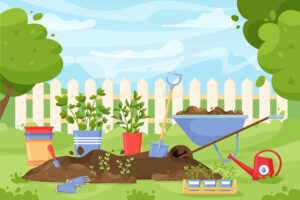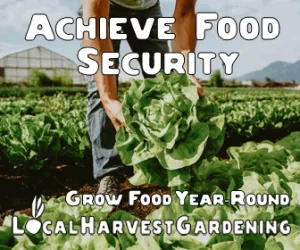What is Lasagna Gardening?

Lasagna gardening has become a popular method of vegetable gardening and utilizes layers of materials as opposed to a traditional soil-based approach. It is also known by other names such as “sheet composting” or “lasagna mulching.”
Lasagna Gardening originated with the publication of the book “Lasagna Gardening: A New Layering System for Bountiful Gardens: No Digging, No Tilling, No Weeding” – by Patricia Lanza in 1998. The author developed the method during a time when she was unable to prepare her garden’s soil traditionally due to medical issues. Since then, lasagna gardening has evolved and is now widely used by gardeners of all skill
Why Choose Lasagna Gardening
Lasagna gardening has several environmental and cost-effective benefits. It is well known to be an easy way to start a garden without the need of digging, tilling or weeding. This method also helps conserve water, reduce compaction, increase soil fertility and reduce erosion. Additionally, it can help create gardens with fewer weeds, as weeds are often less able to penetrate the layers of organic materials.
Cost Effectiveness of Lasagna Gardening
Lasagna gardening is a great way to start a garden with minimal cost. It doesn’t require extensive soil preparation, expensive tools, or large amounts of fertilizer or pesticides. Additionally, many materials used for lasagna gardening are recyclable organic materials that you can find around the house.
Time-saving Nature of Lasagna Gardening
Lasagna gardening is also a great way to save time. It’s easy to prepare beds and get them ready to be planted with minimal effort. Additionally, it helps reduce the amount of time spent weeding as weeds are prevented from germinating due to the materials used in lasagna gardening.
Overall, Lasagna Gardening can be a great way to start a bountiful garden with minimal effort, cost and time. It’s an efficient method that can help you create lush, healthy gardens without all the hard work.
Step-by-Step Guide to Lasagna Gardening
Choosing the right location
For your lasagna garden is key to getting the best results. Choosing an area with adequate sunlight, access to water and space for growth are all important factors. You may want to spend some time observing the sunlight on your property. It’s important to consider how that might change across the seasons since the sun changes tract slightly across seasons. Also, consider if you have trees that will leaf out and create shade.
Preparing the layers
Once you’ve chosen a location, it’s time to start layering. First, add layers of cardboard or newspaper on the soil surface. If using newspaper you want at least 6 layers. I’ve seen this method used on top of concrete and bedrock and do very well. Be sure to soak your cardboard.
This method can be done directly on your lawn with or without a border. You and do it as a means of filling raised beds too. If you are going to do it directly on your lawn you want the cardboard to extend two feet in every direction to make paths and prevent the grass from growing into your bed.
Then add layers of organic materials such as compost, leaves, pine needles, grass clippings and straw. It’s important to add a layer of topsoil or compost between each layer so that the soil can keep some moisture and nutrients in it. I like to sprinkle blood meal and bone meal on each layer as well.
Water each layer of your lasagna garden generously as you go until all the layers are saturated.
How many layers?
It’s important to note that the more layers you have, the deeper your lasagna garden will be. A standard depth for a lasagna garden is around 1-2 feet deep. If you are adding soil or compost between each layer you want it to be at least 6 inches thick.
These layers will settle as the organic material decomposes.
Planting Your Lasagna Beds
Once your lasagna garden is set up and the layers have begun to decompose, it’s time to start planting. You can sow seeds or plant seedlings directly into the top layer of compost or soil. Just make sure to water well after planting.
When planting seedlings, ensure the hole is deep enough to accommodate the roots. Carefully place the plant in the hole, then gently backfill with compost or soil. For seeds, refer to the instructions on the package regarding planting depth and spacing.
Remember, you can plant pretty much anything you would in a traditional garden in a lasagna garden. The enriched soil from your lasagna layers provides an ideal environment for most plants to thrive.
Make sure to keep the garden well-watered, especially in the early stages of plant growth. As the organic material continues to decompose, it will release nutrients into the soil, creating a rich and fertile environment for your plants.
Maintaining Your Lasagna Beds
Once you’ve built your lasagna garden, it’s important to keep it properly maintained. Water regularly and deeply so that the soil stays moist. This will help the decomposing process occur faster as well as keep your plants happy and healthy.
If any weeds pop up, pull them out or use a hoe to loosen them from the soil. Be careful not to disturb the soil too much or you may disrupt the mycorrhizal webs that are essential for a healthy garden.
You can also add compost or other organic matter to your beds throughout the growing season to help provide additional nutrients for your plants. Add mulch around plants to help conserve moisture and keep weeds down.
Conclusion
Lasagna gardening is a great way to build healthy, fertile soil and create lush, productive gardens. With the right balance of organic material and water, you’ll find that your lasagna beds will soon be filled with thriving plants!
For more articles on gardening check here.
Happy gardening!
Resources:

